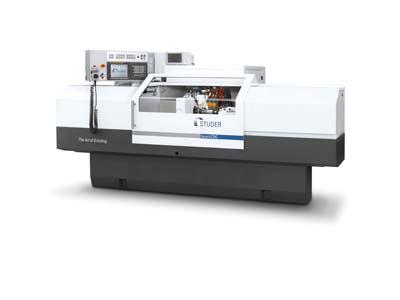
United Grinding Technologies says the new Studer favoritCNC universal cylindrical grinder provides unheard of versatility for small budgets and high standards. This CNC universal cylindrical grinder is designed for grinding medium-sized workpieces in individual and serial production. With various options, such as in-process gaging, balancing systems, contact detection and length positioning, plus a grinding length of 25.6", a center height of 6.9", a workpiece weight of 176 lb. and a grinding wheel diameter of 20 x 2.5 x 8", the favoritCNC can be adapted for many grinding applications.
The machine bed made of solid Granitan S103 forms the foundation of the cylindrical grinder, which is equipped with high quality components and can guarantee exacting precision, performance and reliability for years.
The practical Studer grinding software with its proven pictogramming means that even less experienced users can quickly and efficiently program grinding and dressing cycles. The optional StuderGRIND software is also available, and allows special applications, such as profiling wheels for complex workpiece shapes to be programmed efficiently.
The material structure developed by Studer has proven its superb efficiency over many years and is produced in the company's own plant. The excellent dampening behavior of the machine base ensures outstanding surface quality of the ground workpieces. The service life of the grinding wheel is also increased, leading to reduced downtime. Temporary temperature fluctuations are extensively compensated by the favorable thermal behavior of Granitan. This provides high stability throughout the day.
The V and flat guideways for the cross slides are molded directly into the machine base and are finished with a non-abrasive Granitan S200 slide way coating. The patented surface structure prevents the slides from hydroplaning and eliminates the stick-slip effect, which can be found in conventional guideways. The guideways offer the best possible accuracy throughout the speed range with high load capacity and dampening levels.
The longitudinal and cross slides are manufactured from high quality gray cast iron and have very precise ground V and flat guideways, with the distance between guideways optimally suited to the machines overall rigidity. The slides rest completely on the guideways on the machine bed through the entire speed range, which is the basis for the excellent straightness of 0, 0025mm over 650mm measuring length. The slides are advanced by 40mm diameter circulating ballscrews connected to a three-phase servo motor via torsion resistant, bellow-type couplings. This enables the axes to achieve high process speeds on one hand, while short auxiliary times also guarantee maximum precision with in-feed movements of 0.0001mm on the other. Use of the swiveling machine table on the longitudinal slide enables the whole length of the surface to be grounded and acts as a support for the workhead, the tailstock, and also accessories and devices.
The turret wheelhead can be used for both external and internal grinding. It can be equipped with an extra grinding wheel and internal grinding spindle for this purpose. With extreme precision, the user can manually (2.5 degrees) index the turret wheelhead in a Hirth gear within a swiveling range of -15 degrees/ +195 degrees. Grinding wheel dimensions: diameter 19.69 inches, width of 2.48" x 3.15", bore of 7.99". It has a drive power of 12 hp. The cutting speed maximum of 9,843 sfpm enables efficient removal values during the grinding process. The speed of the belt-driven internal grinding spindle can be infinitely variably regulated.
Spindles are available with nominal speeds of 20,000, 40,000 and 60,000 rpm. The generously dimensioned barrel, designed for the deployment of MT4 taper centers, glides in the tail stock housing. The fine adjustment enables taper corrections in the range below 1µm when grinding between centers. In order to guarantee optimum thermal stability, a cooling lubricant is passed through the tail stock, and completely covers the barrel and diamond holder.
The versatile universal workhead with MT5 fitting taper is capable of both live spindle grinding and grinding between centers. The workhead spindle is mounted on roller bearings, in low maintenance and processes an excellent roundness accuracy of the below 0.0004mm. The fine adjustment allows for cylindrical corrections in the 1µm range during live spindle operations. Extreme runout accuracy is 0.000016", chucked or between centers. The workhead provides 1-1,500 rpm for the right speed for each unique application.
The Fanuc 0i CNC with active flat color monitor (10.4 inches) is reliable and optimally matched to the drive elements. All controls are clearly and ergonomically arranged. The optional Sensitron electronic contact detection function enables downtimes to be reduced to a minimum. Pictogramming: the operator strings the individual grinding cycles together, and the control system generates the ISO code. Grinding and dressing process sequences can be programmed freely to optimize the grinding process.
StuderGRIND: programming software for special applications such as profiling the grinding wheel for complex workpiece forms. The program is created on the PC and transfers directly to the machine control unit.
Contact Details
Related Glossary Terms
- centers
centers
Cone-shaped pins that support a workpiece by one or two ends during machining. The centers fit into holes drilled in the workpiece ends. Centers that turn with the workpiece are called “live” centers; those that do not are called “dead” centers.
- computer numerical control ( CNC)
computer numerical control ( CNC)
Microprocessor-based controller dedicated to a machine tool that permits the creation or modification of parts. Programmed numerical control activates the machine’s servos and spindle drives and controls the various machining operations. See DNC, direct numerical control; NC, numerical control.
- cutting speed
cutting speed
Tangential velocity on the surface of the tool or workpiece at the cutting interface. The formula for cutting speed (sfm) is tool diameter 5 0.26 5 spindle speed (rpm). The formula for feed per tooth (fpt) is table feed (ipm)/number of flutes/spindle speed (rpm). The formula for spindle speed (rpm) is cutting speed (sfm) 5 3.82/tool diameter. The formula for table feed (ipm) is feed per tooth (ftp) 5 number of tool flutes 5 spindle speed (rpm).
- dressing
dressing
Removal of undesirable materials from “loaded” grinding wheels using a single- or multi-point diamond or other tool. The process also exposes unused, sharp abrasive points. See loading; truing.
- flat ( screw flat)
flat ( screw flat)
Flat surface machined into the shank of a cutting tool for enhanced holding of the tool.
- grinding
grinding
Machining operation in which material is removed from the workpiece by a powered abrasive wheel, stone, belt, paste, sheet, compound, slurry, etc. Takes various forms: surface grinding (creates flat and/or squared surfaces); cylindrical grinding (for external cylindrical and tapered shapes, fillets, undercuts, etc.); centerless grinding; chamfering; thread and form grinding; tool and cutter grinding; offhand grinding; lapping and polishing (grinding with extremely fine grits to create ultrasmooth surfaces); honing; and disc grinding.
- grinding wheel
grinding wheel
Wheel formed from abrasive material mixed in a suitable matrix. Takes a variety of shapes but falls into two basic categories: one that cuts on its periphery, as in reciprocating grinding, and one that cuts on its side or face, as in tool and cutter grinding.
- in-process gaging ( in-process inspection)
in-process gaging ( in-process inspection)
Quality-control approach that monitors work in progress, rather than inspecting parts after the run has been completed. May be done manually on a spot-check basis but often involves automatic sensors that provide 100 percent inspection.
- profiling
profiling
Machining vertical edges of workpieces having irregular contours; normally performed with an endmill in a vertical spindle on a milling machine or with a profiler, following a pattern. See mill, milling machine.

